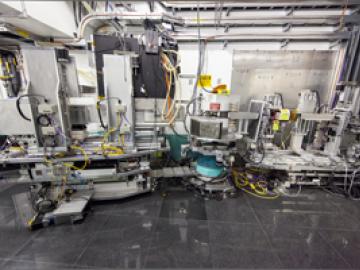Filter News
Area of Research
- (-) Climate and Environmental Systems (4)
- (-) National Security (2)
- Advanced Manufacturing (4)
- Biological Systems (3)
- Biology and Soft Matter (3)
- Building Technologies (3)
- Chemical and Engineering Materials (2)
- Chemistry and Physics at Interfaces (5)
- Clean Energy (20)
- Computational Biology (1)
- Computational Chemistry (4)
- Computational Engineering (1)
- Computer Science (1)
- Earth Sciences (1)
- Energy Frontier Research Centers (6)
- Fuel Cycle Science and Technology (1)
- Functional Materials for Energy (8)
- Fusion and Fission (1)
- Geographic Information Science and Technology (1)
- Isotopes (1)
- Materials (33)
- Materials for Computing (7)
- Materials Synthesis from Atoms to Systems (8)
- Materials Under Extremes (5)
- Neutron Data Analysis and Visualization (2)
- Neutron Science (7)
- Nuclear Science and Technology (5)
- Nuclear Systems Technology (1)
- Quantum Condensed Matter (2)
- Renewable Energy (1)
- Sensors and Controls (1)
- Supercomputing (15)
- Transportation Systems (3)
News Type
News Topics
Media Contacts
ORNL drone and geospatial team becomes first to map the Coca River in the Amazon basin as erosion and sediment threaten Ecuador’s lands.

Jack Orebaugh, a forensic anthropology major at the University of Tennessee, Knoxville, has a big heart for families with missing loved ones. When someone disappears in an area of dense vegetation, search and recovery efforts can be difficult, especially when a missing person’s last location is unknown. Recognizing the agony of not knowing what happened to a family or friend, Orebaugh decided to use his internship at the Department of Energy’s Oak Ridge National Laboratory to find better ways to search for lost and deceased people using cameras and drones.

depth, population-based approach to identifying such mechanisms for adaptation, and describes a method that could be harnessed for developing more accurate predictive climate change models. For the U.S. Department of...

Thomas Wilbanks and Benjamin Preston, both of the Climate Change Science Institute (CCSI) at Oak Ridge National Laboratory (ORNL), are among the 309 coordinating lead authors of the Intergovernmental Panel on Climate Change’s (IPCC’s) Working Group II (WG II) report.

Carbon dioxide in the atmosphere may get the lion’s share of attention in climate change discussions, but the biggest repository of carbon is actually underfoot: soils store an estimated 2.5 trillion tons of carbon in the form of organic matter.

Former Energy Secretary Steven Chu mixed his Wigner Distinguished Lecture on Feb . 12 with a description of his current research at Stanford and his outlook on energy policy and climate change.




